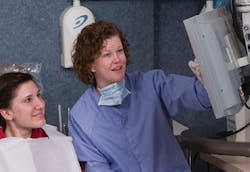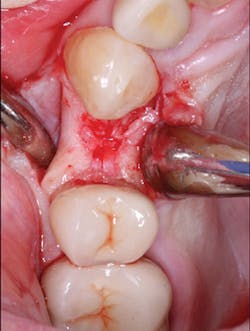Sensitivity in Class I and II composites is still present
By Gordon J. Christensen, DDS, MSD, PhD
Q I've been practicing dentistry for only two years, and I have a challenge that occurs occasionally. I use resin-based composite for almost all Class I and II restorations. Most of the time the restorations are relatively pain-free after placement, with the occasional exception of cold sensitivity for a few days postoperatively. However, once in a while, a newly placed restoration has either lingering cold sensitivity or pain when the patient bites down and releases the pressure on the tooth. I've had to do endodontic treatment on some teeth when the sensitivity persists. What can I do to eliminate this disagreeable and unpredictable problem?
A You are not alone! I challenge you to find a practicing clinical dentist who has not had the problems you described. We at Clinicians Report Foundation (formerly CRA) receive thousands of calls from practicing dentists each month. Your question is a frequently asked one, and has been so for several decades. Many research projects have been done on the physical properties of resin-based composite restorative materials, primarily because such research is relatively easy and fast to accomplish in a well-equipped physical science laboratory. However, only a few projects have been done on the presence of postoperative sensitivity, leading occasionally to pulpal death, as you described.
I will provide suggestions based on my interpretation of the research available, our own research in Clinicians Report Foundation, and my personal clinical observations from my prosthodontic practice. I feel very confident that you will not continue to have the problem if you follow a few simple clinical procedures. I know that some readers will disagree with the suggestions, as there are many solutions to every clinical problem.
Tooth preparation
Use good judgment as you prepare the tooth for a Class I or II restoration, and regardless of the size or depth, use light touch and water spray as your make the preparation. Prepare the tooth as though it is a normal moderate-depth restoration, leaving remaining deep caries, without making the preparation into the deepest portions. It is well known that moderate-depth Class I and II resin restorations have only a few postoperative sensitivity challenges with resin restorations, and they are not the major problem. (Fig. 1) Deep preparations usually provide the major sensitivity problems.
After making the initial gross tooth preparation, slow down, turn off the water, and remove the deepest portion using only very light touch and slower speed. As you approach the deepest portion, use gentle touch with a sharp spoon excavator. If the deepest portion appears to be pink in color (not bleeding), determine if you want to leave the last portion of relatively hard caries, thus avoiding a pulp exposure, and place a liner, which is often called an indirect pulp cap.
Tooth disinfection and desensitization
We have researched many types of chemicals to accomplish tooth disinfection and/or desensitization, including benzalkonium chloride, sodium hypochlorite, chlorhexidine, and glutaraldehyde. All of these chemicals have a positive effect for disinfection and desensitization. The one I suggest to you is 5% glutaraldehyde and 35% HEMA, which is marketed as GLUMA, Glu/Sense, G5, MicroPrime, and others. They vary up to 600% in cost, but they have the same constituents.
Place one of these solutions on the tooth preparation for two one-minute applications, which has been confirmed by Dr. Rella Christensen in the TRAC component of the CR Foundation (Clinicians Report, Nov. 2009, Vol. 2, Issue 11) to successfully desensitize and disinfect the tooth preparation. Use only a small amount of the liquid on a microtip (Fig. 2), since the materials will potentially irritate soft tissue. Some practitioners don't like to take two minutes for this procedure, but lack of sensitivity is well worth the time. However, any time short of the two minutes is still valuable. Do NOT wash off the solution; instead, place your high-velocity suction tip over the prep and use a light air stream to pick up the excess solution.
Liners for deep Class I and II resin restorations
Liners have always been controversial, and many materials have been used as liners. They still have a valuable purpose in deep tooth preparations. The most popular liners are still resin-modified glass ionomers (Vitrebond Plus from 3M ESPE, or Fuji Lining Cement LC from GC). (Fig. 3) However, newer materials such as TheraCal LC from Bisco are effective and becoming popular. These liners should be on the deepest portions only and be limited to about 0.5 mm to 1.0 mm in thickness.
Bonding agent placement
Total-etch (etch and rinse), selective etch, and self-etch can all be used with success. However, for a deep preparation when sensitivity is anticipated, I prefer either selective-etch or self-etch. New products shown to be very acceptable by Clinicians Report Foundation include Optibond XTR from Kerr, Peak from Ultradent, Prime&Bond Elect™ from Dentsply Caulk, and Scotchbond™ Universal Adhesive from 3M ESPE.
Placement of resin-based composite
Curing lights have various levels of adequacy, and numerous clinical researchers have noted the inadequacy of some light brands that do not function properly. Check your light. It should be delivering at least 1,000 mW per cm2. Many are not! In spite of the popularity of the currently vogue "bulk fill" concept, if your light is not curing adequately, sensitivity is only one of the maladies that can occur from inadequate polymerization.
In my opinion, the "gold standard" for resin placement is still the safest and most predictable. It involves placing a thin layer of resin (0.5 mm) in the depth of the box form, letting it adjust to the body heat for a few seconds (which eliminates the need for flowable resin unless you prefer to use one), curing it, then placing 1.0 mm for the next layer and 2.0 mm for subsequent layers. This technique will provide adequately cured resin with almost any light and will reduce the chance for postoperative tooth sensitivity.
Here is an extremely important precaution when curing. In most offices, the dental assistant is the person curing the resin. The assistant should have the light in one hand and the air syringe in the other. As the light is turned on and aimed at the tooth and resin, the air stream should also be aimed at some portion of the tooth to cool it while the light is applied. Excess heat has been proven to cause pulpal damage that shows up later as the pulp is not able to recover from the heat damage.
Finishing and polishing
Use care in finishing and polishing to avoid removing external enamel and dentin. (Fig. 4) Aggressive finishing and polishing can remove the external layer of fluoride on the tooth surface and cause opening of dentinal canals in areas where dentin is present. This aggressive finishing and polishing is another potential reason for postoperative tooth sensitivity.
Occlusion
It is no mystery that leaving occlusion too high causes near-immediate postoperative tooth sensitivity. Most articulating papers mark almost every tooth that is even close to touching. They are NOT accurate and can be misleading. Check occlusion very carefully with an accurate occlusal evaluation media in a dry field such as AccuFilm® II from Parkell, Madame Butterfly Silk from Almore, or TrollFoil from TrollDental. (Fig. 5)
Summary
Class I and II resin-based composites can be predictably non-sensitive, but many of the techniques accomplished by some dentists can cause this undesirable and potentially expensive problem, and lead to upset patients, ill will, confrontation, and the potential need for endodontic treatment.
Gordon Christensen, DDS, MSD, PhD, is a practicing prosthodontist in Provo, Utah. He is the founder and director of Practical Clinical Courses, an international continuing-education organization initiated in 1981 for dental professionals. Dr. Christensen is a cofounder (with his wife, Dr. Rella Christensen) and CEO of CLINICIANS REPORT (formerly Clinical Research Associates).
In this monthly feature, Dr. Gordon Christensen addresses the most frequently asked questions from Dental Economics® readers. If you would like to submit a question to Dr. Christensen, please send an email to [email protected].
Additional Resources
We have many educational resources to assist you in not having postoperative tooth sensitivity. Among them are:
- One-hour video "Class II Composite Resins Can Be Predictable, Non-Sensitive, and Profitable" (Item # V3554), showing the most proven procedures in close-up detail and as I have described in this article.
- Two-day hands-on course, "Successful, Real-World Practice-Restorative Dentistry" with Dr. Christensen in Utah that includes most of the techniques in overall esthetic restorative dentistry. " src="../Images/placeholder.jpg"> • Two-day hands-on course, "Successful, Real-World Practice-Restorative Dentistry" with Dr. Christensen in Utah that includes most of the techniques in overall esthetic restorative dentistry.
Contact Practical Clinical Courses at 800-223-6569 or visit the website at www.pccdental.com
Past DE Articles





